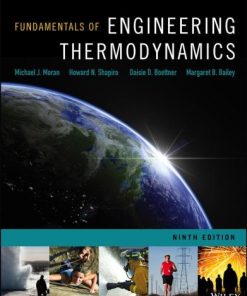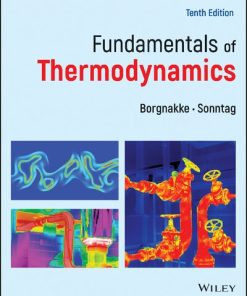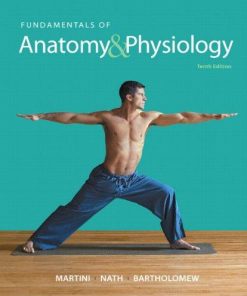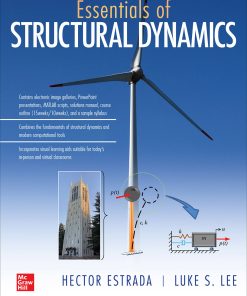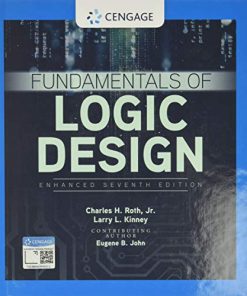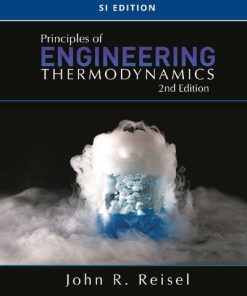Fundamentals of Thermodynamics 1st Edition by John Lee, Ramamurthi 1000533200 9781000533200
$50.00 Original price was: $50.00.$25.00Current price is: $25.00.
Fundamentals of Thermodynamics 1st Edition by John H. S. Lee, K. Ramamurthi – Ebook PDF Instant Download/DeliveryISBN: 1000533200, 9781000533200
Full download Fundamentals of Thermodynamics 1st Edition after payment.
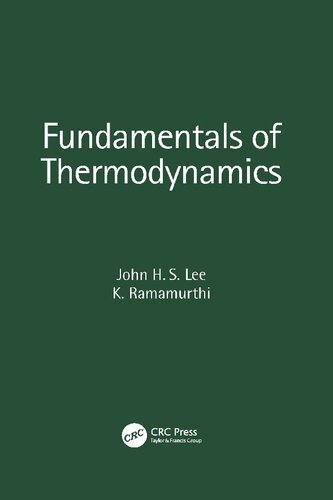
Product details:
ISBN-10 : 1000533200
ISBN-13 : 9781000533200
Author : John H. S. Lee, K. Ramamurthi
A concise treatment of the fundamentals of thermodynamics is presented in this book. In particular, emphasis is placed on discussions of the second law, a unique feature of thermodynamics, which states the limitations of converting thermal energy into mechanical energy. The entropy function that permits the loss in the potential of a real thermodynamic process to be assessed, the maximum possible work in a process, and irreversibility and equilibrium are deduced from the law through physical and intuitive considerations. They are applicable in mitigating waste heat and are useful for solving energy, power, propulsion and climate-related issues. The treatment is not restricted to properties and functions of ideal gases. The ideal gas assumption is invoked as a limiting case. Reversible paths between equilibrium states are obtained using reversible heat engines and reversible heat pumps between environment and systems to determine the entropy changes and the maximum work. The conditions of thermodynamic equilibrium comprising mechanical, thermal, chemical and phase equilibrium are addressed and the species formed at equilibrium in a chemical reaction at a given temperature and pressure are obtained. The molecular basis for the laws of thermodynamics, temperature, internal energy changes, entropy, reversibility and equilibrium are briefly discussed. The book serves as a reference for undergraduate and graduate students alongside thermodynamics textbooks.
Fundamentals of Thermodynamics 1st Table of contents:
Chapter 1 Fundamental Concepts
1.1 System and Environment
1.2 State of a System
1.3 Simple Systems
1.4 Mass, Molecular Mass and Moles in a System
1.5 Intensive Variables Defining a System
1.5.1 Pressure
1.5.2 Temperature
1.5.2.1 Empirical Temperature θ
1.5.2.2 Absolute Temperature T
1.5.2.3 Temperature in K and °C
1.6 State of a System: State Variables/Thermodynamic Properties
1.7 Change of State of a System: Quasi-Static, Reversible and Cyclic Processes
1.7.1 Quasi-Static Process
1.7.2 Reversible Process
1.7.3 Cyclic Process: Efficiency and Coefficient of Performance
Chapter 2 Equation of State
2.1 Introduction
2.2 Equation of State for an Ideal Gas
2.3 Equations of State for Real Gases
2.3.1 Virial Equation of State
2.3.2 van der Waal’s Equation of State
2.3.3 Berthelot and Dieterici Equations of State
2.3.4 Redlich–Kwong Equation of State
2.4 Compressibility Factor and Generalized Compressibility Chart
2.5 Mixture of Ideal Gases
Chapter 3 First Law of Thermodynamics
3.1 Statement of the First Law
3.2 Internal Energy and Adiabatic Work
3.3 Heat
3.4 Heat Capacity of a System
3.4.1 Heat Capacity at Constant Volume
3.4.2 Heat Capacity at Constant Pressure
3.4.3 Relation between Heat Capacities
3.4.4 Specific Heats
3.5 Internal Energy and Enthalpy for an Ideal Gas
3.6 Experimental Verification of Dependence of Internal Energy on Temperature, Specific Volume and Pressure
3.7 Experimental Verification of Enthalpy to Be Independent of Pressure for an Ideal Gas
3.8 First Law Applied to Open Systems
Chapter 4 Second Law of Thermodynamics
4.1 Statements of the Second Law
4.2 Equivalence of Kelvin-Plank and Clausius Statements
4.3 Carnot’s Principle
4.3.1 Efficiencies of Reversible Engines
4.4 Heat Transfer and Temperature
4.5 Thermodynamic Temperature
4.5.1 Efficiency of Reversible Engine Depends on Temperature of Both Reservoirs
4.5.2 Thermodynamic Temperature Ratios
4.5.3 Thermodynamic or Absolute Temperature Scale
4.6 Clausius Inequality
4.7 Entropy
4.7.1 Entropy Statement of the Second Law
4.7.2 Equivalence of Entropy Statement of Second Law and Clausius and Kelvin-Plank Statements
Chapter 5 Entropy
5.1 Entropy between Two States
5.2 Path Independence
5.3 Generalized Expression for Entropy Change
5.3.1 Entropy from Internal Energy Changes: (Variables T and V)
5.3.2 Entropy from Enthalpy Changes: (Variables p and T)
5.3.3 Entropy Changes as a Function of Heat Capacities: (Variables p and V)
5.4 Entropy Changes for an Ideal Gas
Chapter 6 Reversible Work, Availability and Irreversibility
6.1 Reversible Work
6.2 Work from Different Reversible Paths between Two States
6.3 Reversible Work of a System Interacting with Environment: Availability Φ
6.4 Reversible Work of a System Interacting with Reservoir and Environment
6.5 Reversible Work When System Changes Its Volume
6.6 Irreversibility of a System Undergoing a Process
6.7 Two Examples Illustrating Irreversibility
6.7.1 Expansion of an Ideal Gas into Vacuum
6.7.2 Cooling of a Cup of Hot Coffee
6.8 Irreversibility in Open Systems
Chapter 7 Thermodynamic State Functions
7.1 Introduction
7.2 State Functions
7.2.1 Internal Energy
7.2.2 Entropy
7.2.3 Enthalpy
7.2.4 Helmholtz- and Gibbs-Free Energies
7.2.5 Summary of Relationships between State Properties
7.3 Derivation of State Functions using the Legendre Transform
7.4 Maxwell’s Relationships for State Variables
7.5 Thermodynamic Potentials and Forces
7.6 Determination of State Functions
7.6.1 Internal Energy
7.6.2 Enthalpy
7.6.3 Entropy
7.7 Thermodynamic Functions for Dense Gases
7.8 Generalized Enthalpy and Entropy Charts
Chapter 8 Thermodynamic Coefficients and Specific Heats
8.1 Thermodynamic Coefficients
8.1.1 Coefficient of Volume Expansion
8.1.2 Isothermal and Isentropic Compressibility
8.1.3 Pressure Coefficient
8.1.4 Relationships among the Coefficients
8.2 Specific Heats
8.2.1 Specific Heats at Constant Pressure cp and Constant Volume cv
8.2.2 Ratio of Specific Heats
8.2.3 Variation of Specific Heats cv and cp with Specific Volume v and Pressure p
8.3 Joule Thomson Coefficient
8.4 Thermodynamic Coefficients for Dense Gases
Chapter 9 Thermodynamic Equilibrium
9.1 Introduction
9.2 Equilibrium Criterion
9.3 Thermal Equilibrium
9.4 Mechanical Equilibrium
9.5 Equilibrium with Mass Exchange
9.6 Chemical Potential
Chapter 10 Equilibrium of Species in a Chemically Reacting System
10.1 Introduction
10.2 Choice of Basic Datum for the State Functions and Heat of Formation
10.3 Entropy of the Species in a Chemical Reaction: Third Law of Thermodynamics
10.4 Enthalpy Changes
10.5 Product Species in a Chemical Reaction at a Given Temperature and Pressure
10.6 Example of Determining Equilibrium Composition
10.7 Chemical Equilibrium of Species at Given Temperature and Volume
10.8 Corrections for Real Gas: Fugacity
Chapter 11 Statistical Thermodynamics
11.1 Introduction
11.2 Distribution of Particles and Their Energy Levels: Bose–Einstein, Fermi–Dirac and Boltzmann Statistics
11.3 Maxwell–Boltzmann Distribution: Partition Function
11.4 Boltzmann’s Formula
11.5 Partition Function for a Monoatomic Gas: Internal Energy, Pressure, Equation of State and Entropy of an Ideal Gas
11.6 Reversible Heat Transfer, Work and The First Law
11.7 Entropy and the Second Law
People also search for Fundamentals of Thermodynamics 1st:
fundamentals of thermodynamics 10th edition
fundamentals of thermodynamics 9th edition pdf
fundamentals of thermodynamics 8th edition
fundamentals of thermodynamics 11th edition
fundamentals of thermodynamics 10th edition pdf
Tags: Fundamentals, Thermodynamics, John Lee, Ramamurthi
You may also like…
Business & Economics - Responsibility and Business Ethics
Business & Economics - Professional Finance
Fundamentals of Multinational Finance, 6th Edition, Global Edition Michael H. Moffett
Physics - Thermodynamics
Medicine - Anatomy and physiology
Fundamentals of Anatomy & Physiology 10th Edition Frederic H. Martini
Engineering - Engineering Technology
Essentials of Structural Dynamics Hector Estrada And Luke S. Lee
Engineering - Electrical & Electronic Engineering
Fundamentals of Logic Design, Enhanced Edition 7th Edition Jr. Charles H. Roth






